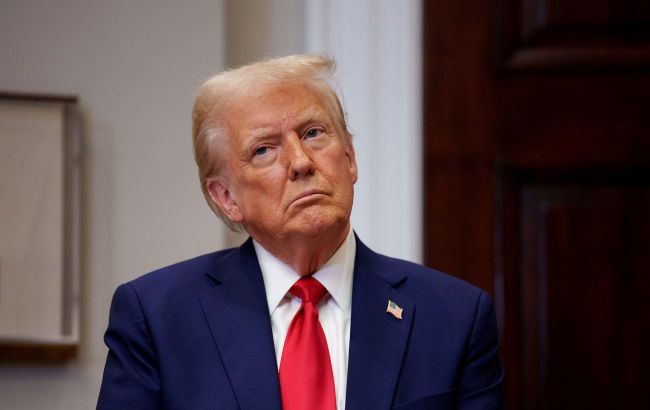US government shutdown: Trump’s goals and consequences for Ukraine
 Donald Trump (photo: Getty Images)
Donald Trump (photo: Getty Images)
The US federal government is on the verge of a shutdown.
RBC-Ukraine explains the reasons behind this and what the potential consequences for Ukraine might be.
Key questions:
- Why do government shutdowns happen so often in the US?
- What are the US budget issues this year?
- How might Trump use a shutdown to his advantage?
- What could be the consequences for Ukraine?
Almost every autumn, the US witnesses a political thriller called “The Threat of a Shutdown.” This is a temporary halt of the federal government if Congress has not approved the budget for the upcoming year. Unlike in Ukraine, the US fiscal year begins on October 1, not January 1. As a result, the government machinery in the US could be put on pause as early as this week.
Why have US government shutdowns become regular
Over the past forty years, the US federal government has shut down 21 times. In the 1980s, the country’s modern budget system was established, strengthening Congress’s role in approving the federal budget and setting clear deadlines for doing so.
As a result, every year Democrats and Republicans try to push spending items in the budget that benefit their own agendas. Passing the budget requires a simple majority in both chambers of Congress – the Senate and the House of Representatives. However, even if one party holds such a majority, it does not always resolve the situation.
US legislative practice includes the concept of the filibuster. This is a tactic for delaying the Senate’s process through endless debate. It is based on rules allowing unlimited discussion unless an agreement is reached to end it. Ending a filibuster requires a 60-vote majority out of 100, which is rarely held by any single party.
In the context of the budget, a filibuster cannot block the entire bill. This procedure can only be applied to legislation known as a continuing resolution, which maintains federal funding at the previous year’s levels, but only for a specified period.
Quick compromises are not always achievable for both parties, so if the sides fail to reach an agreement, a shutdown occurs.
Typically, a government shutdown lasts days or weeks. The longest shutdown occurred in 2018–2019 during Trump’s first term, lasting 35 days. It was triggered by a dispute over funding for the border wall with Mexico. According to Bloomberg, shutdowns usually have a limited short-term economic impact, but prolonged halts of government institutions can reduce GDP growth by 0.4% in the quarter during which they occur.
What is the current problem
This year, as in the past, the crisis stems from political disagreements between the two parties in Congress. It is also fueled by the Democrats’ antagonism toward Trump and their desire to obstruct his agenda as much as possible.
In Congress, where Republicans hold a narrow majority in the House of Representatives (218 to 213) and the Senate (53 to 47), procedural hurdles have prevented the timely preparation of a completely new budget. As a result, a new continuing resolution must be passed by October 1.
Republicans would like to simply extend government funding at the current level until November 21. Democrats, on the other hand, insist on including additional spending for healthcare. Consequently, the Senate rejected both proposals, and senators adjourned for a recess.
Shutdown as a pretext
US President Donald Trump has taken a hardline stance. At a briefing on September 19, he expressed skepticism about the possibility of a compromise and emphasized that Democrats are insisting on funding programs that, in his view, are not a priority.
“I don't know if you can make a deal with these people. I think these people are crazy,” he said.
The President stated that in the event of a shutdown, the government would continue to fund the military, social programs, and certain other areas.
At the same time, according to Reuters, Trump could use the shutdown as a pretext for large-scale purges of the federal bureaucracy. Previously, civil servants frequently contested their dismissals in court, which often undermined the intended reductions.
A shutdown, as a force majeure circumstance, could solve this problem for Trump. The White House has asked federal agencies to prepare plans for mass layoffs in case of a possible government shutdown next week. Previously, during shutdowns, officials were typically placed on unpaid leave.
Democrats, in turn, accuse Trump of attempting to consolidate power under the pretext of a shutdown, and they blame Republicans for refusing to compromise, which they say threatens the country’s economic stability.
What’s next
Currently, several scenarios are possible. The most likely is a short-term shutdown. In this case, Congress could return to negotiations after October 1 and quickly approve a temporary budget.
Another scenario is a concession by one side. Democrats might agree to a clean continuing resolution to avoid a shutdown, or Republicans could make concessions on healthcare spending.
However, given Trump’s hardline rhetoric and the polarization in Congress, a quick agreement seems unlikely. Moreover, a shutdown provides a prime opportunity for both political camps to blame their opponents for being uncooperative.
Consequences for Ukraine
A potential shutdown is likely to affect Ukraine only indirectly. Since returning to the office, Donald Trump has not introduced any new aid programs for Ukraine. Packages under the PDA (Presidential Drawdown Authority) and USAI (Ukraine Security Assistance Initiative) programs, initiated during Biden’s administration, continue to supply weapons from previously authorized funds, but no new significant allocations have been made.
Currently, Ukraine receives weapons from the US, including through the PURL (Prioritized Ukraine Requirements List) program. This program allows the US to provide weapons purchased for Kyiv by European countries - either from US stockpiles or directly from American defense manufacturers. The US Department of Defense plays a coordinating role in this process.
Therefore, a short-term shutdown should not affect US support for Ukraine. However, if the shutdown is prolonged and the Pentagon partially suspends operations, delays in administering contracts for new weapons are possible.
Statements from American politicians and articles by The Hill, Reuters, and Bloomberg were used in preparing this report.

